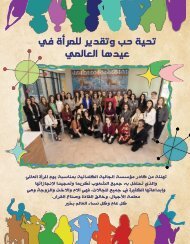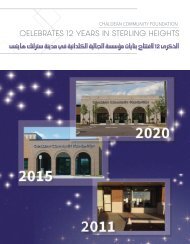JANUARY 2019
Create successful ePaper yourself
Turn your PDF publications into a flip-book with our unique Google optimized e-Paper software.
100 Questions and Answers about Chaldeans<br />
BY ASHOURINA SLEWO<br />
Working with his students,<br />
author and Michigan<br />
State University journalism<br />
professor, Joe Grimm, has published<br />
a number of cultural competence<br />
guides about various cultures.<br />
His fifteenth and latest guide puts<br />
the spotlight on the Chaldean community.<br />
The book, “100 Questions and<br />
Answers About Chaldeans” came<br />
on the heels of the raids led by Immigration<br />
and Customs Enforcement<br />
(ICE) in June of 2017 that<br />
lead to the detainment of hundreds<br />
of community members. These community<br />
members faced deportation.<br />
With these massive raids came<br />
many misunderstandings regarding<br />
the Chaldean community. It became<br />
clear to Grimm that a cultural competence<br />
guide about the community<br />
was now more important than ever.<br />
“With people being detained for<br />
possible deportation, we had to act,”<br />
explained Grimm. “It is a journalist’s<br />
job to report relevant information<br />
when it is needed. We saw this<br />
guide and these times as our clear<br />
obligation to serve the public.”<br />
While the deportations play a<br />
part in the making of “100 Questions<br />
and Answers About Chaldeans”,<br />
Grimm had always planned<br />
to write this guide about Chaldeans.<br />
The raids bumped it up on his list of<br />
guides to write, though.<br />
“What makes a guide about<br />
Chaldean American special is that<br />
this place – southeast Michigan –<br />
is the heart of Chaldean America.<br />
That gives our people a tremendous<br />
advantage and a big responsibility<br />
to learn what we can locally and to<br />
share it widely,” said Grimm.<br />
“Personally, the first peer of non-<br />
European descent I spent an extended<br />
time with was a classmate when<br />
I was a student at St. Bede’s School<br />
in Southfield. That was more than<br />
50 years ago. After St. Bede’s, I attended<br />
Brother Rice High School,<br />
where I met more Chaldeans. Living<br />
my whole life in the Detroit area, I<br />
have known Chaldean Americans<br />
in many contexts.”<br />
In order for Grimm’s guides to be<br />
useful, the process of writing each<br />
guide is thorough. First, they begin<br />
by conducting interviews to learn<br />
what Chaldean Americans to describe<br />
basic, everyday questions or<br />
assumptions non-Chaldeans have<br />
about the community.<br />
“These can be questions or assumptions<br />
that Chaldeans hear all<br />
the time or questions they think<br />
people really ought to have the answers<br />
to,” said Grimm.<br />
In writing these guides, Grimm<br />
and his students have four ethics.<br />
They are to be respectful of the people<br />
they write about, be accurate in<br />
portraying the identities, be authoritative<br />
by using solid sources, and be<br />
accessible.<br />
The guides are meant to be accessible<br />
as possible. For this reason,<br />
the books are made available in<br />
print and digital at a low cost across<br />
a number of platforms.<br />
Grimm and his students then<br />
edit each other. In addition, they<br />
solicit critiques at the formative and<br />
question writing stages as well as at<br />
the end of the process.<br />
In this process, several members<br />
of the Chaldean community<br />
have had the opportunity to guide<br />
Grimm and his students.<br />
“These guides cannot possibly<br />
be done without help from experts<br />
in the community. They have been<br />
kind, knowledgeable and patient<br />
with us as they explained things or<br />
corrected our work,” said Grimm.<br />
“We approached people from many<br />
perspectives. People we worked<br />
with directly included Bishop<br />
Francis Kalabat and Fathers Manuel<br />
Boji, Pierre Konja and Patrick<br />
Setto. Others were Vanessa Denha<br />
Garmo, who advised before the class<br />
even began and who then visited it.<br />
Martin Manna has a similarly vital<br />
role.”<br />
Other community experts include<br />
author Jacob Bacall, Mary<br />
Romaya, Mariann Sarafa and Ann<br />
Rabban from the Chaldean Cultural<br />
Center, Zina Salem and Jane<br />
Shallal of the United Community<br />
Family Services (Chaldean American<br />
Ladies of Charity) and even the<br />
president of the Chaldean Heritage<br />
Foundation, Tom Alkatib.<br />
Other notable community members<br />
assisted, including Judge Diane<br />
D’Agostini, State Representative<br />
Klint Kesto, Assistant Metro Editor<br />
Sally Tato, Margaret Saroki-<br />
Shamoun, chair of TEACH, and<br />
Joe Sarafa. Providing several photos<br />
is Wilson Sarkis.<br />
Topics covered in “100 Questions<br />
and Answers About Chaldeans” will<br />
range from the church, employment<br />
and entrepreneurship to myths and<br />
stereotypes in the community.<br />
“The church is very important<br />
and not widely understood. The<br />
church is central. So is family. The<br />
distinctions of religion, nationality<br />
and cultural tradition have to<br />
be explained,” said Grimm. “The<br />
growth of our Chaldean community<br />
in terms of education and employment,<br />
especially entrepreneurship,<br />
is a real story of success and needs to<br />
be understood.”<br />
“Things are not as they were. We<br />
wanted to examine Chaldeans’ historic<br />
origins and, of course, contemporary<br />
history in the United States<br />
and Iraq. It is both tragic and hopeful.”<br />
Grimm hopes readers of this<br />
guide will learn about the flourishing<br />
Chaldean community of metro Detroit<br />
and be confident in their interactions<br />
with Chaldean Americans.<br />
“It is very simple. We wish to give<br />
people the confidence to have better<br />
conversations with Chaldeans,”<br />
explained Grimm. “We want them<br />
to feel less afraid that they will ask<br />
a question that is hurtful or that embarrasses<br />
them. This is a slim little<br />
guide and is just a starting point, not<br />
the whole story.”<br />
There is not yet a release date<br />
for “100 Questions and Answers<br />
About Chaldeans.” When released,<br />
it will be available for purchase on<br />
Amazon.<br />
<strong>JANUARY</strong> <strong>2019</strong> CHALDEAN NEWS 25

















